Capitoline Art Story | Location | Schedule Tickets | Authorisations
The Capitoline Museum, the Capitoline Museums in Rome, Italy
The Capitol: A Masterpiece Owed to the Genius of Michelangelo
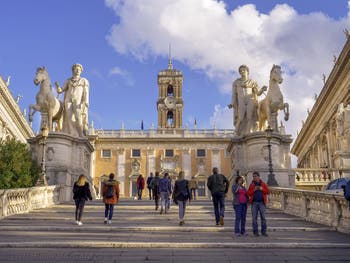
Capitoline monumental stairway Located at the top of Capitoline Hill, these museums and the surrounding square were designed and created by Michelangelo.
As an architect, he was, in fact, responsible for the restructuring of all this part of Rome.
And we can speak of success: harmonious, grandiose and beautiful are the words that come to mind after climbing the monumental staircase that leads to the square.
In 1537, Pope Paul III Farnese entrusted Michelangelo with the project to develop this place, with the first task of transferring the equestrian statue of Emperor Marcus Aurelius from the Lateran where it was located, and installing it in the centre of the future Capitoline Square.
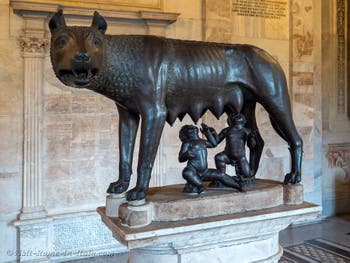
Capitoline Wolf Completing the entire project, which also included the transformation of the Senate Palace, required nearly a century of work to complete the construction of the Palais Neuf.
The Capitoline Museum Collections
The history of the collections of the Capitoline museums began more than sixty years before Paul III's project.As early as 1471, Pope Sixtus IV (who named the Sistine Chapel after him) donated works previously located in the Lateran Episcopal Palace.
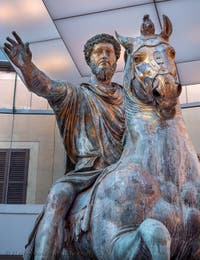
Marcus Aurelius These included the famous “Wolf” and the monumental head of Constantine.
Some believe it was initially the head of the colossal statue of Nero, whose features would then have been modified to look like Constantine (see our article on the Colosseum).
This gift from Sixtus IV was not purely free since it confirmed the domination of papal power over Rome.
In addition to the equestrian statue of Marcus Aurelius, numerous other ancient sculptures formerly in front of the Palace of the Conservators joined the collections between the end of the 15th and the beginning of the 16th centuries.
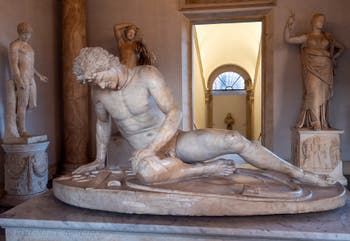
Dying Gaul - Dying Galatian In 1513, colossal statues of river deities and numerous reliefs were added to the previous statues.
In 1566, Pope Pius V donated dozens of statues that belonged to the Vatican collections.
These works were then joined by other exceptional statues such as the “Capitoline Venus”, “the dying Galatine”, and some quality Egyptian sculptures.
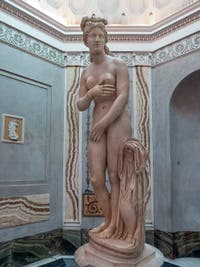
Capitoline Venus Ancient coins, porcelain, Etruscan vessels, busts and statues of Roman emperors, busts of philosophers and other celebrities of the ancient world completed collections that were already exceptionally rich.
The Masterpieces of the Capitoline Art Gallery
But the beauty of the works of art exhibited in these museums doesn't stop at the marble and bronze.
The Pinacoteca is just as exceptional.
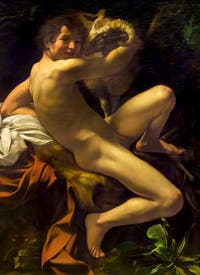
Caravaggio Among other things, you can admire:
- A superb “Saint John the Baptist” and “The Fortune Teller” by Caravaggio,
- The “Abduction of Europe” by Paolo Veronese,
- As it should be here, a “Romulus and Remus” by Peter Paul Rubens,
- A portrait of the “Wael Brothers” by Anton Van Dyck,
- A magnificent “Self-portrait” by Diego Velázquez.
The Tabularium of the Senatorial Palace
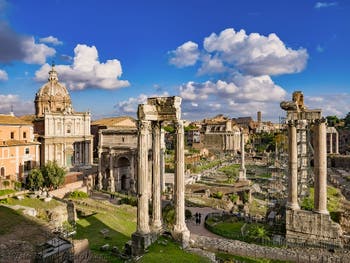
The Roman Forum saw from the Tabularium In addition to the lapidary gallery that links the two Capitoline museums, you should not miss a visit to the Upper Gallery of the Tabularium at no cost.
You will discover an exceptional and moving view of the entire Roman Forum with the bonus, in the background, the Colosseum.
An absolutely magical view, especially at night if you are lucky enough to go there in winter when the days are short.
The lighting in ruins and the Colosseum is simply superb!
The Capitoline Museums are a "must" in Rome, and for the works of art you can admire there, and for visiting the places: Exceptional!
Capitoline Art Story | Location | Schedule Tickets | Authorisations
Back to Top of Page

